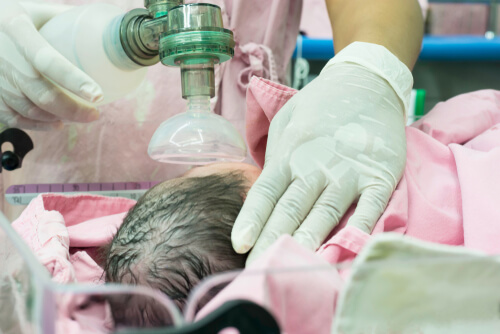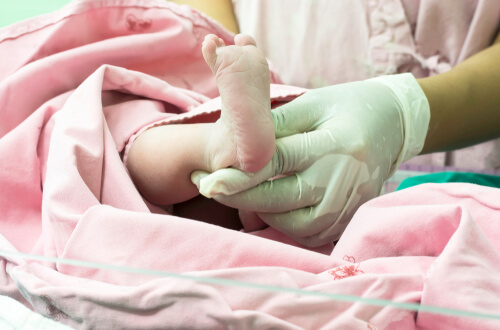Cyanosis or Purple Skin: Symptoms and Treatment

Cyanosis or purple skin occurs when a bluish color appears on the skin. It’s usually related to a lack of oxygen in the blood. Among the first signs of the onset of this disease are that the baby’s lips and fingers turn blue.
In addition, it can occur suddenly accompanied by breathing problems and other symptoms that we’ll mention below.
Symptoms of cyanosis or purple skin
Generally, babies with this disease tend to have difficulty gaining weight and may have a low weight from birth. They also might tire quickly when they’re feeding.
If you notice a bluish color in the fingers, lips, or feet of your baby, you must be extremely attentive to any of the following symptoms that might appear:
- They’re easily irritated.
- They’re underweight and have difficulty gaining weight.
- They aren’t particularly active.
- Their nostrils feel like they’re burning due to their breathing difficulties.
- They make noises when they breathe.
- They’re susceptible to repeated respiratory infections.
- There’s a thickening of the last joint of their fingers.

Types of cyanosis or purple skin
It’s important to note that there are several types of cyanosis and each is due to a different cause. Therefore, tests should be performed to determine what type of cyanosis is present and to decide on the appropriate treatment. Here, we mention the cause of each type of cyanosis:
Central cyanosis
This type of cyanosis is also known as acrocyanosis. In this kind, the bluish color occurs mainly in the lip area. It may also occur in the fingers or toes.
It’s caused by diseases of the heart or lungs or by abnormal hemoglobin types such as methemoglobin or sulfhemoglobin.
Other causes
- Injury during birth.
- Respiratory distress syndrome.
- Pulmonary edema.
- Herniated diaphragm.
- Upper airway obstruction.
Transient cyanosis
If the child presents this type of cyanosis, their hands and feet take on a bluish color, particularly if they’re in a cold area. It’s caused by the vasoconstriction of blood vessels due to the cold.
This kind is extremely common in newborns and can last several days.
Peripheral cyanosis
This type mainly affects the extremities. It occurs when there’s a decrease in local blood circulation in the peripheral organs. It can be seen when the baby presents a bluish color in their arms and legs. They’ll also feel cold to the touch.
Peripheral cyanosis can also appear when the arterial blood doesn’t have normal levels of oxygen. It could be due to a lung disease or heart defects.
Other causes
- Decreased blood pumping by the heart.
- Diseases such as thrombosis or embolism.
- Constriction of blood vessels in the extremities.
When deoxygenated hemoglobin reaches between 4-6 g dl, this is the stage when possible cyanosis can be detected.
Treatment
Treatment depends on the type of cyanosis. Therefore, it varies in each individual case. However, here are some of the measures.
- If the baby presents cyanosis caused by exposure to cold (transient cyanosis), it’s of vital importance to warm the child quickly, using heating or wrapping them up.
- If it’s due to congenital heart defects, surgery is possible.
- It may be treated through the use of a respiratory ventilator.
- It’s also possible, in some cases, to treat cyanosis with intravenous fluids.
- If the infant is found to have transposition of the great arteries (TGA) as a cause of cyanosis at birth, an injection of prostaglandin may be given.

What tests will the doctor perform when faced with cyanosis or purple skin?
If the doctor suspects the existence of the disease, they’ll perform various tests to determine the cause of the appearance of cyanosis and its type. These include:
- Chest x-ray.
- Cardiac catheterization.
- Oxygen saturation monitoring.
- Blood tests.
Finally, you should always pay attention to the color of your baby’s skin. If it takes on a bluish hue at any time you must consult a doctor immediately. Although there are several symptoms related to this disease, this is usually the most obvious sign and the one that indicates the presence of cyanosis with greater certainty.
Cyanosis or purple skin occurs when a bluish color appears on the skin. It’s usually related to a lack of oxygen in the blood. Among the first signs of the onset of this disease are that the baby’s lips and fingers turn blue.
In addition, it can occur suddenly accompanied by breathing problems and other symptoms that we’ll mention below.
Symptoms of cyanosis or purple skin
Generally, babies with this disease tend to have difficulty gaining weight and may have a low weight from birth. They also might tire quickly when they’re feeding.
If you notice a bluish color in the fingers, lips, or feet of your baby, you must be extremely attentive to any of the following symptoms that might appear:
- They’re easily irritated.
- They’re underweight and have difficulty gaining weight.
- They aren’t particularly active.
- Their nostrils feel like they’re burning due to their breathing difficulties.
- They make noises when they breathe.
- They’re susceptible to repeated respiratory infections.
- There’s a thickening of the last joint of their fingers.

Types of cyanosis or purple skin
It’s important to note that there are several types of cyanosis and each is due to a different cause. Therefore, tests should be performed to determine what type of cyanosis is present and to decide on the appropriate treatment. Here, we mention the cause of each type of cyanosis:
Central cyanosis
This type of cyanosis is also known as acrocyanosis. In this kind, the bluish color occurs mainly in the lip area. It may also occur in the fingers or toes.
It’s caused by diseases of the heart or lungs or by abnormal hemoglobin types such as methemoglobin or sulfhemoglobin.
Other causes
- Injury during birth.
- Respiratory distress syndrome.
- Pulmonary edema.
- Herniated diaphragm.
- Upper airway obstruction.
Transient cyanosis
If the child presents this type of cyanosis, their hands and feet take on a bluish color, particularly if they’re in a cold area. It’s caused by the vasoconstriction of blood vessels due to the cold.
This kind is extremely common in newborns and can last several days.
Peripheral cyanosis
This type mainly affects the extremities. It occurs when there’s a decrease in local blood circulation in the peripheral organs. It can be seen when the baby presents a bluish color in their arms and legs. They’ll also feel cold to the touch.
Peripheral cyanosis can also appear when the arterial blood doesn’t have normal levels of oxygen. It could be due to a lung disease or heart defects.
Other causes
- Decreased blood pumping by the heart.
- Diseases such as thrombosis or embolism.
- Constriction of blood vessels in the extremities.
When deoxygenated hemoglobin reaches between 4-6 g dl, this is the stage when possible cyanosis can be detected.
Treatment
Treatment depends on the type of cyanosis. Therefore, it varies in each individual case. However, here are some of the measures.
- If the baby presents cyanosis caused by exposure to cold (transient cyanosis), it’s of vital importance to warm the child quickly, using heating or wrapping them up.
- If it’s due to congenital heart defects, surgery is possible.
- It may be treated through the use of a respiratory ventilator.
- It’s also possible, in some cases, to treat cyanosis with intravenous fluids.
- If the infant is found to have transposition of the great arteries (TGA) as a cause of cyanosis at birth, an injection of prostaglandin may be given.

What tests will the doctor perform when faced with cyanosis or purple skin?
If the doctor suspects the existence of the disease, they’ll perform various tests to determine the cause of the appearance of cyanosis and its type. These include:
- Chest x-ray.
- Cardiac catheterization.
- Oxygen saturation monitoring.
- Blood tests.
Finally, you should always pay attention to the color of your baby’s skin. If it takes on a bluish hue at any time you must consult a doctor immediately. Although there are several symptoms related to this disease, this is usually the most obvious sign and the one that indicates the presence of cyanosis with greater certainty.
All cited sources were thoroughly reviewed by our team to ensure their quality, reliability, currency, and validity. The bibliography of this article was considered reliable and of academic or scientific accuracy.
- Medlineplus. (2021). Coloración azul en la piel. Consultado el 28 de enero de 2022. https://medlineplus.gov/spanish/ency/article/003215.htm.
- Herranz M, Clerigue N. (2003). Poisoning in children. Methaemoglobi- naemia. An Sist Sanit Navar. 26 (Suppl. 1): 209-23.
- Kyavar, M., & Sadeghpour, A. (2014). Cyanosis. In Comprehensive Approach to Adult Congenital Heart Disease.
- Sánchez, M. P., Del Moral, C. R., Rodríguez, C. S., Casso, S. J., & De Guevara, M. P. V. (2008). Crisis aguda de cianosis en un lactante. Boletín de Pediatría, 48, 124-127. https://www.sccalp.org/documents/0000/0050/BolPediatr2008_48_124-127.pdf.
- Dezube R. (2021). Cianosis. Manual MSD. Consultado el 12 de febrero de 2023. https://www.msdmanuals.com/es/hogar/trastornos-del-pulm%C3%B3n-y-las-v%C3%ADas-respiratorias/s%C3%ADntomas-de-los-trastornos-pulmonares/cianosis.
- Fundación Española del Corazón. (S.F.) Transposición de grandes vasos. Consultado el 12 de febrero de 2023. https://fundaciondelcorazon.com/informacion-para-pacientes/enfermedades-cardiovasculares/transposicion-de-grandes-vasos.html.
- Instituto Nacional del Cáncer. (S.F.). Metahemoglobinemia. Consultado el 12 de febrero de 2023. https://www.cancer.gov/espanol/publicaciones/diccionarios/diccionario-cancer/def/metahemoglobinemia.
- MedlinePlus. (2021). Fenómeno de Raynaud. Consultado el 12 de febrero de 2023. https://medlineplus.gov/spanish/ency/article/000412.htm.
This text is provided for informational purposes only and does not replace consultation with a professional. If in doubt, consult your specialist.








